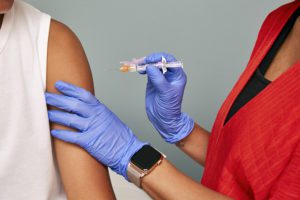by Gertrud Rey


In a highly publicized press release dated May 18, 2020, the biotech company Moderna announced preliminary results from a phase I clinical trial for a SARS-CoV-2 vaccine candidate. However, the company only provided brief, conclusory statements at that time. On July 14, the results from the trial were finally published in the New England Journal of Medicine.
The vaccine candidate is named “mRNA-1273” because it consists of an mRNA (messenger RNA) that encodes the full length, 1,273 amino acid SARS-CoV-2 spike protein. The mRNA is encapsulated in a lipid nanoparticle, which protects the mRNA from degradation and ensures proper delivery into cells. Upon injection into a vaccine recipient, the mRNA would enter cells and be translated by the host protein synthesis machinery into the SARS-CoV-2 spike protein, which would then serve as an antigen to promote an immune response. The spike protein has been the primary antigenic choice for a number of SARS-CoV-2 vaccine candidates because it mediates binding of the virus to the ACE2 host cell receptor via its receptor-binding domain (RBD) and fusion of the viral particle with the host cell membrane via its fusion domain. Both of these domains are highly immunogenic and are targeted by neutralizing antibodies, which bind viral antigens to inactivate virus and prevent infection of new cells.
Phase I clinical trials typically involve a small group of patients and aim to identify which dose of a new drug produces optimal outcomes with the fewest side effects. The Moderna trial enrolled 45 healthy adults, ranging in age from 18-55. Vaccine recipients were divided into three groups, with individuals in each group receiving a dose of either 25, 100, or 250 micrograms of mRNA-1273 in two injections spaced 28 days apart. The key observations were as follows:
- side effects were mild to moderate;
- all subjects produced RBD- and fusion domain-binding IgG antibodies by day 15 post-vaccination;
- responses were dose-dependent, with higher vaccine doses eliciting higher levels of antibodies;
- subjects in all dose groups produced RBD- and fusion domain-specific neutralizing antibodies only in response to the second dose;
- binding and neutralizing antibody levels in recipients of the 100 and 250 microgram doses were similar in magnitude to those observed in sera from SARS-CoV-2-recovering patients; and,
- recipients of the 25 microgram dose also produced T helper cells, while recipients of the 100 microgram dose produced both T helper cells and cytotoxic T cells specific to the vaccine spike protein (for a review of the relevance of these cells click here).
Overall these results seem promising; mRNA-1273 activated both arms of the adaptive immune response by inducing both neutralizing antibody and T cell responses specific to the SARS-CoV-2 spike protein RBD and fusion domains. Moreover, because the mRNA encodes the full-length spike protein, vaccine recipients may also produce non-neutralizing antibodies specific to additional potentially immunogenic domains. As noted by immunologist Jon Yewdell in a recent letter to TWiV, non-receptor-binding domains may not mediate classic neutralization of virus in an vitro scenario, but they may provide additional protection in infected individuals. For example, flu studies in mice have shown that non-neutralizing antibodies may also protect against disease by various mechanisms that have yet to be identified. Furthermore, RNA-based vaccines are considered safer than traditional vaccines because they don’t contain infectious virus. They are particularly suitable for emerging pathogens because they can be produced more quickly and cost-effectively than traditional vaccines.
However, the trial also had several limitations. The study group was small and the vaccine was not tested in subjects over the age of 55, a group who often mount a weaker immune response and are more likely to develop severe COVID-19. At the present time it is also impossible to know how long the observed immune responses will last because it has been less than two months since the trial participants were immunized. Because SARS-CoV-2 is considered a dangerous pathogen, traditional challenge trials, in which an immunized individual is intentionally infected with the pathogen against which he was immunized, will likely not be done, so we have no way of knowing if the vaccine is effective until vaccine recipients have been naturally exposed to the virus. It may also be difficult to know whether a person was exposed. Moreover, because mRNA vaccines have never been licensed for use in humans, there are many unknown factors, such as the potential for unanticipated long-term side effects.
There is no doubt that we are in dire need of a vaccine for SARS-CoV-2. However, a vaccine has to be both safe and effective, two criteria that have repeatedly crippled the development of vaccines for respiratory syncytial virus, herpes simplex virus, hepatitis C virus, and HIV, just to name a few. While the results from the Moderna vaccine trial warrant cautious optimism, it is too early to draw valid conclusions in regard to efficacy and long-term protection. An ongoing placebo-controlled phase II trial evaluating the efficacy of 50 and 100 microgram doses of mRNA-1273 in 600 healthy adults, and an upcoming phase III efficacy trial aiming to evaluate the 100 microgram dose in 30,000 participants, will hopefully provide more definitive answers.
[The Moderna mRNA-1273 vaccine was previously discussed on episodes 592, 616, 626, and 637 of TWiV.]

Pingback: A SARS-CoV-2 Vaccine Candidate – Virology Hub
Pingback: Preliminary phase I/II results of ChAdOx1 SARS-CoV-2 vaccine
Pingback: A SARS-CoV-2 Vaccine Candidate - Virology Hub